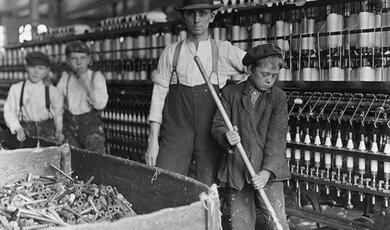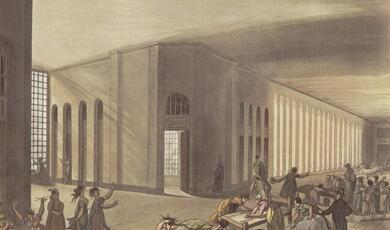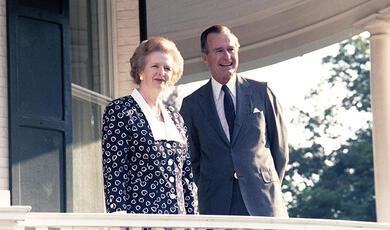Engine House, 1760 to 1830
Share
- Details
- Text
- Audio
- Downloads
- Extra Reading
England’s take off as the first industrial nation created a whole new language of building underpinned by technology and by an emerging view of the rest of the world.
This is a part of the lecture series From Architectural Periphery to the World's Engine House: English Building from the Reformation to the First World War.
In this lecture series Simon Thurley continues his investigation into the history of building in England. Starting with the shattering events of the Suppression of the Monasteries and the Civil War he moves on to look at the architectural consensus that briefly reigned in the mid-eighteenth century before it dissolved in the white heat of the Industrial Revolution. Economic and technological change then drove English building in remarkable new directions for over 150 years. This period was ended by another shattering event, but this time of global proportions – the First World War. This extraordinary chronicle is not just history of architecture, but the history of an ascendant civilization.
Download Text
8 February 2012
Engine House:
1760 - 1830
Professor Simon Thurley
The period we are going to deal with tonight is one of the shortest I have covered in this whole series of lectures. It is a mere seventy years. But seventy years of such radical change and fundamental importance that it deserves its own fifty minutes to consider it. In previous lectures I have followed the twists and turns of style and function, the growth of new building types and the decline of others. Tonight I want to deal with a fundamental change that came to affect English society and building construction. This takes us away from the traditional discourse of architecture for tonight stylistic development cannot be our principal focus.
We saw last time that during the early eighteenth century a much more correct use of the classical orders of architecture developed. Public buildings like Horse guards, country houses, like Houghton, the house of the Prime Minister and even civic buildings like the Mansion House, home of the mayor followed printed examples of Roman buildings illustrated in books. From the 1750s and 60s the intensity of interest in getting classical buildings right intensified as archaeology began to show what the domestic roman architecture was really like. Architects like James Wyatt and Robert Adam introduced into their buildings much more correct interpretations of classical architecture. But they, like their predecessors, practiced just as much in other styles, increasingly in gothic, but in Greek and even Egyptian. The cannon opened up and we have a much greater diversity of appearance.
These stylistic trends, particularly the greater interest in archaeology and the first hand study of classical remains are a factor in what I want to speak of tonight, but what I want to concentrate on is most often described as the industrial revolution. The first thing to say is that I’m not dealing with the age of the steam train, that starts in 1830, in fact I’m not dealing with the world in which minerals propelled the economy. The whole of the period up to 1830 remained a time when the economy was principally based on the power of men and of beasts, of water and wind. This is vitally important to remember for though, from around 1760, the English economy rapidly grows and diversifies the great shift to coal power had not yet taken place.
So what were the ingredients of this and how did they affect the English landscape? I see what happens from the late 1750s as being fundamentally determined by water: in three ways, by overseas trade by inland navigation and by water power.
By the mid eighteenth century England was the world’s greatest trading nation. The nature of its trade had fundamentally changed, although Europe remained the principal trading partner much of Britain’s trade was long distance, and much towards the Americas. Whilst the export of manufactured goods, especially textiles, remained important re-export of exotic goods was a big component of overseas trade. Imports now tended to be of raw materials rather than finished goods. In all this the geography of trade had changed, it was the western ports that were important now and in particular Bristol and Liverpool which was the port for the manufactories of the north.
Liverpool developed the first enclosed docks in the world. The city corporation set out to solve the problems of berthing ships on the Mersey with its strong currents, big tidal range and shifting sandbanks. Thomas Steers built a 3.5 acre wet dock for unloading ships that opened in 1715. Such a thing had, of course, been built before by the Royal Navy, but this was a commercial operation which allowed trading ships to load and unload at ay time of tide. By 1800 Liverpool had 25.7 acres of dock, while no other port in the world had even one. None of the pre 1840 docks has survived but Jesse Hartley’s sublime Albert Dock (1843-7) remains. The 1 million square foot warehouse complex is built round a 7.75 acre dock. The principal materials are granite, cast iron and brick, for this was not only secure, it was fireproof. We shall see in a few minutes that the model for fireproof warehouses comes from the textile mills, but by the inclusion of squat primitive Greek Doric columns and expansive brick arches that allowed ships cranes to swing goods on the dockside beneath the colonnade, Hartley introduced fashionable architectural details. Here is the Traffic Office also designed by Hartley with the help of Philip Hardwick. The massive Doric portico is made of cast iron and show how the great engineers were right up-to-the-minute in using correctly observed Greek details on their structures. London docks followed those at Liverpool relieving intolerable congestion and rife pilfering at the world’s busiest port. The West India, London and east India Docks transformed London’s cargo handling.
England’s trading interests had been secured by the Royal Navy. From the 1650s the job that the Navy was required to do began to change. Rather than being a seasonal operation laid up over winter, the fleet was increasingly kept at sea the year round and the navy acquired bases all over the world to make this possible. In England extensive on-shore facilities were constructed including ordnance yards, gunpowder stores, victualling yards as well as docks and facilities for construction and repair. The first naval bases were on the Thames and the Medway but during the eighteenth century Britain’s strategic interests moved westwards and Portsmouth and Plymouth rose in importance and became the bases from which the sea-going fleet was maintained. This fleet was vital to the economy, security and mentality of the English nation.
Indeed the Navy came to symbolise English political and religious liberty, but it was really during the seven years war of 1756 to 1763 that Pitt the Elder translated made the navy into the most powerful force in the world. This power, whilst relying on fine ships and modern tactics, was actually founded on the excellence of naval administration. In this its naval bases were key. The great storehouses at Portsmouth started in 1674 could be mistaken for one of the magnificent aristocratic terraces of Mayfair. Here is the drawing for the prosaically named number 10 store. This is a building that proclaims the confidence and order of a world beating organisation. The dry docks, slips, mast houses, sail lofts and roperies of the dockyards were amongst the largest buildings ever constructed in England and built and refitted the fleet.
But technical naval engineering was not what made the royal navy invincible it was mastery of victualling. The length of time that ships could stay at sea was determined by the quantity of food and drink available. The Royal William yard designed by John Rennie the younger and started in 1824 was the navy’s showpiece. This was a vast victualling depot. Clustered round a tidal basin were wharves, a brewery, a flour mill, bakery, cooperage, slaughterhouse, five houses for senior officers offices cranes and two water reservoirs. The whole was surrounded by a massive wall and entered by a magnificent gate. This incredible complex was built of local stone and stitched together with cast and wrought iron for columns, joists and roof members.
We have seen that England’s navigable waterways played a vital part in its economic development from earliest times. Some 700 miles of natural and improved river were navigable in 1700; sixty years later a further 600 miles of navigation had been added through the improvement of rivers. Yet there were many places that were still 25 or 20 miles from any navigation and from the 1760s artificial waterways, canals, began to be built on a large scale. In the mid 1790s 62 different canals, half the entire navigable waterways system were under construction.
At first coal was key to this. The first coal carrying canal was built from the Duke of Bridgewater’s mines at Worsley to Manchester. It was an obvious solution as one horse with a barge could pull 30 tons of coal - more than ten times that which a single horse and cart could. The first canals, like the Bridgewater canal, were narrow, winding contour-hugging watercourses. They were dug by farm labourers but by the 1790s there were gangs of navigators or navvies, as they were known, who only worked on canals; eventually there were contracting firms who would cut the canals, excavate tunnels and build bridges. Water was retained in the channels by puddled clay and, on one side, the spoil was hardened to serve as a towpath. In the 1760s a unique craft was invented, around 70ft long and only 7ft wide, with a large open hold suitable for grain, coal, stone or sand with a small cabin at the back. These Narrow Boats were lethal on rivers or estuaries, because they would capsize in a trice, but were cheap to build and could move quickly in shallow canals.
Unlike rivers canals were, of course, not natural watercourses and so needed to be fed by streams, springs or in upland areas reservoirs. The first purpose-built reservoirs were built in the 1790s and from the same period many canals were fed by means of steam-powered pumps. About 6 Miles from Marlborough on the Kennet and Avon Canal is Crofton Pumping Station built in 1807 to provide water to the summit of the canal which is 40ft above any reliable water source.
Changes in level and connections with other navigations were managed by means of Pound Locks. These had been used since the sixteenth century but technology rapidly developed in the 1760s leading to the brick chambers closed off with timber lock gates and sluices familiar today; my example here is from the Taunton Canal. From the 1770s it became more common to try and group locks together. A rise of immediately adjacent locks or a flight (which is a sequence of locks separated by short pounds) enabled boats to ascend or descend more rapidly and steeper gradients to be navigated. The Bingley five rise (Yorkshire) was completed in 1774 and could take a boat through a 59ft level change in 28 minutes. Bingley demonstrates both masterful engineering and deliberate aesthetic impact achieved by the designers.
Huge numbers of brick and stone bridges were built often to a standardised design by canal-company contractors. On the Oxford Canal a company, Hollingsworth and Coates, built bridges at £50 a go with locally quarried stone (Napton Bridge). From the 1790s some began to be constructed of cast iron like that over the Kennet and Avon Canal in Bath cast in Coalbrookdale in 1800. Some iron castings were architecturally pretentious such as Macclesfield Bridge in Regents Park, London with chunky Greek Doric columns 1815-16. The most spectacular bridges, however, carried canals themselves. The first navigable aqueduct (the Barton) to be built in England was constructed on the Bridgewater canal in 1761. The Duke had seen both Roman aqueducts and French experiments and was determined to build a successful acquaduct himself. These structures somehow had a romance and an historical association. King amongst all these was the pontcysyllte acquaduct, a cast iron trough made of precast plates bolted together. Completed in 1805 and designed by Thomas Telford it is just over 1,00ft long raised up on elegant stone arches.
Crucially the new canals linked long established river navigations and by 1790 the Thames, Severn, Trent and Mersey were all joined together in a single network. At the intersections were transhipment points where goods could be moved from barge to river-going vessel. Stourport upon Severn was basically an entirely new town built by the Staffordshire and Worcestershire canal company. Here were large basins, warehouses, offices, a hotel and soon an inland resort with fine terraces of houses. Ellesmere Port did the same job at the intersection with the river Mersey.
The canals were publicly authorised by Act of Parliament by privately financed by the creation of a joint stock company and the issuing of shares. The Trent and Mersey Canal, for instance raised £130,000 by selling shares worth £200 each. Profits were made from tolls and from leasing dock and warehouse space. Some toll houses still survive, that at Bratch Locks at Wombourne on the Staffordshire and Worcestershire Canal is an elegant brick hexagon. The canal companies built themselves offices that expressed their aspirations, those of the Kennet and Avon Canal Company in Bath, built in about 1810, straddles the canal itself atop a rusticated bridge (Cleveland house by Pinch the Elder 1817-20). It contained a 20ft high boardroom, ante-rooms and secure storage and is amongst the earliest purpose-built offices in England.
Most companies built maintenance yards containing forges, wet or dry docks stables and joiner’s shops. Hartshill Yard, on the Coventry Canal Warwickshire built in c.1800 is a fine brick multi-purpose maintenance depot with a wet dock, mess room, blacksmith’s and carpenter’s shops and stores surrounded by a stout wall. It is more than a functional structure with its cupola, blank arches and measured elevations. Big windows admitted light into the workshops and chunky exposed roof trusses created uninterrupted space.
Let’s not forget how radical all this was. Yes, of course it transformed the ability to move goods around, particularly iron and coal, but it invented a whole new architectural vocabulary. Offices, warehouses, whole new towns. And many of these were standardised in a way that had not been the case before. The exact same buildings replicated dozens of times along a canal length. The canals pre-figured the railways and a whole world of standardisation that was to follow from the 1830s.
However we must be clear here. The canals were not the answer to everything for they tended to integrate regional economies, the roads, however, facilitated the national economy. By the Restoration England was covered by an effective system of road transport. Goods were delivered either by packhorses or by four-wheeled wagons and people were conveyed to most provincial cities by carriages on a regular service. This required a substantial infrastructure of wagon and carriage construction, of horse breeding, inn keeping and warehouse construction. Commercial operators dabbled in all these ventures and made their fortunes, especially in the major provincial capitals. But road transport was problematic. Packhorses continued to be popular because wagons and carriages were slow moving on poor roads. Winter travel was difficult and slow and towns like Leeds were virtually inaccessible on wheeled transport. As a consequence very small numbers of people travelled long distances.
Roads had, before the 1750s been the responsibility of parishes to maintain, but their diabolical state stimulated local businessmen and entrepreneurs to petition for acts of parliament to convert lengths of road into trusts. The trusts repaired and maintained the roads and funded their work through the power to charge tolls. By the mid 1830s 22,000 miles had been turnpiked, perhaps 20% of the whole network. From the 1750s and 60s these turnpike trusts plus new steel springs on carriages and better breeds of sturdier horses made passenger transport infinitely more viable. The turnpikes were closed in the 1880s but in their heyday they relied on a network of toll houses to collect fees. By 1840 there were over 5,000 of these with their distinctive bay fronts to give the pikeman a clear view of the road. Some retain their tollboards. At Athelhampton, Dorset a toll house of about 1840 survives with deep eaves to keep the pikeman dry and a board displaying charges. They were built in a fantastic array of styles responding in the main to local building materials and traditions (eg. Thatched example near Chard).
By the 1790s there was a national network of stagecoaches. In the 1740s it had taken four uncomfortable days to get from London to York now it would take just over a day. The Newmarket Road was terrible; to travel the seventy miles took three days, this too was reduced to less than a day. Before 1800 there were few new roads and the turnpikes transformed existing routes, but afterwards new roads were built many with new bridges. London finally got new road bridges, Vauxhall Bridge in 1816, Southwark Bridge in 1819. The greatest of them all was Grosvenor Bridge Chester by Thomas Harrison which opened in 1833 with a single arched span of 200ft still the widest spanned stone bridge in Britain.
These new roads transformed the towns through which they ran. Inns became even more important as coaches had to change horses every ten to fifteen miles. The Mitre Inn Oxford became a hub with daily services to London. The engraving of the Mitre by J. Fisher dates from c.1825 and shows the Defiance coach, which ran between Oxford, Henley, and London. Big carrying firms such as Thomas Russell and Co that operated between the west country and London owned 200 horses and 30 wagons and employed 60-70 staff. They owned the inns in the towns in which thery operated.
The transformation of roads had a big impact on the great country houses, in the mid eighteenth century the social radius of a house might be nine or ten miles, but after the roads were turnpiked the aristocracy and the gentry were suddenly more mobile, people could travel long distances for a weekend or a single evening. The age of the house party had dawned. At Belvoir Castle, the Duke of Rutland could easily contemplate a birthday party with 300 dining at his table, some stayed, many were able to travel from many miles away for the evening. Owners rebuilt or remodelled their houses to cater for regular entertaining on a huge scale, bigger dining rooms were created libraries became the principal sitting rooms. Neighbours, or families from further afield would come for a drive round the park Great landscapes such as that at Stow House, Buckinghamshire, or Stourhead Wiltshire were toured by carriage. Landscapes round country houses were designed for the off-road vehicles of their time, the new light weight chaises. All this mobility allowed the great estate owners to have their cake and eat it. Most of their time was spent in the city in their lavish town houses in London but they could be in the country when they wanted and invite their London feirnds who could get there quickly and easily when they wanted.
I have dwelt long on transport and make no apology for it. What I have described was a transport revolution that had a huge physical impact on England. Naval dockyards, commercial ports, canal ways and roads introduced a whole new area of construction to town and countryside. But I now need to turn to another great area of innovation, the manufacture of cotton textiles. This was England’s biggest growth industry in the late eighteenth century and also had a huge effect on England’s landscape. Two big changes took place, first there were technical advances in spinning and weaving, then there was a revolution in the way the work was organised.
Richard Arkwright reorganised production housing, in a single building, the processes and machines that carded and spun cotton turning it into a yarn for weaving. This was important because after the invention of the flying shuttle the spinners could not keep the weavers in yarn. Arkwright built a mill at Cromford on the River Derwent where a new piece of technology, the water frame spinning machine, could be powered by waterwheels in the river. Arkwright’s mill ran day and night with two 12 hour shifts churning out yarn by the thousands of miles. The first mill was a five-story stone building, but a second mill was built in 1776-7 and a third in 1785, by the end of the century there was a huge courtyard surrounded by a massive wall to keep out industrial spies.
The mill was manned by women and children while the fathers and husbands were at home weaving in the lofts above their cottages (north street). Weaving was still literally a cottage industry until power weaving came in in the 1820s and 30s. So it was necessary for the big manufacturers to provide housing for the weavers as Arkwright did at north street here (each with its own pigsty). There was also a corn mill, an inn, a market place and a church. Arkwright’s model was, of course, the great aristocratic estate. This was the only model for mass employment in existence, and so while the village looked like a rural estate village belonging to a great country house the mill looked like the great house itself. Big sash windows to let in lots of light, pediments and his Masson Mill built very nearby in 1783-4 had Diocletian windows lighting the stairwells.
By 1797 there were 900 cotton mills in England around 300 of which were of the Arkwright type. Although the first steam engine operated a mill in 1785 water remained the principal source of power until the 1820s. The real challenge was not power but fireproofing. The cotton laden air was prone to catch fire and the Holy Grail was the fireproof mill. Experiments had been made in using iron posts to support the upper floors but the breakthrough came in 1796 at Ditherington Flax Mill where Benjamin Bage used technology developed from canal aqueducts to construct to a five story mill. The floors were carried on shallow brick arches that rested on iron cross beams supported by iron columns. There was thus no exposed timber anywhere; a completely fireproof box had been constructed. This breakthrough led to a revolution in the construction of factories and warehouses such as Albert Dock mentioned earlier. Ditherington is, in a real sense, the ancestor of the skyscraper and the whole prefabricated steel architecture of today.
I have already made the important point that before the 1830s weaving was still done by hand at home. The wool industry for a long time had wool spun by spinsters and woven on hand looms and, after finishing, was brought to town for sale. The pieces of woollen cloth were first sold in open air markets but in 1755 Leeds, which had become England’s largest cloth market, built itself a trading or ‘piece’ hall to which the pieces of woven cloth were brought and in which merchants could trade in security and comfort. Other towns followed, Huddersfield in 1766 and Halifax in 1774. The Halifax Piece Hall, the sole survivor, demonstrates the sense of civic ambition and commercial virility that underpinned provincial commercial architecture. It was probably designed by a young canal engineer and architect, Thomas Bradley. His inspiration was drawn from Alberti’s and Palladio’s reconstructions of Roman Piazzas which were seen as a suitable model for the dignity of the town and the aspirations of its traders. But the building is no copy; it uses the language of classicism loosely, inventing a new rusticated order and deploying the elements in an invented proportional system. It provided over 300 trading rooms and ample space in the vast central court for the poorer singleton traders who could not afford a room. The snobbery of the purist might condemn the Halifax Piece Hall but there is no doubt of the effectiveness of the composition and the impressiveness of the effect.
Now a number of times this evening I have mentioned the sudden and rapid increase in the use of iron in buildings. I have referred to its use in docks, in mills and in the canals. But iron was not new as a structural material in the eighteenth century. Sir Christopher Wren was the first man to use structural iron in England. When the House of Commons needed reconstruction inn 1692 he used exposed iron members in a polite building. Long before him medieval masons had used iron, the spire of Salisbury cathedral is full of it. Wren himself had used a massive iron chain to restrain the dome at St Pauls, but the columns supporting the new galleries in the house of commons were something different. They combined structural integrity, with practical necessity and aesthetic effect.
But the House of Commons was an isolated example and it was a revolution in iron production that made the use of iron so prevalent after 1760. It was the easy access to water power that made the upland parts of England so attractive to iron manufacture. Over ninety metal workshops clustered on the rivers round Sheffield by 1740. Mills either powered grinding machines or forges producing iron. So called blister steel was being made in Sheffield from around 1700 in characteristic brick bottle-shaped furnaces 35ft to 60ft high.
In 1708 in Coalbrookdale in Shropshire Abraham Darby smelted Iron with coke rather than charcoal thus liberating the iron industry from timber linking it inextricably with coal production and placing the two industries either together or linked by the waterways.
Darby’s grandson created the ultimate advertisement for their business the famous iron bridge. This structure was genuinely needed to cross the very deep gorge over the River Severn, but the bridge was primarily an advertisement by the Coalbrookdale iron founders for their business. It was a groundbreaking use of iron. 379 tons were used to span the 100ft gorge 60ft above the water. The design was based on timber structures, even the joints in the bridge were mortise and tennons and dovetails as used in traditional carpentry. But the bridge demonstrated the extraordinary uses to which iron could be put. However the impurities Darby’s iron it made it unsuitable for high performance applications and by the early 1750s a new process was devised that melted the iron in small pottery crucibles, skimmed off the slag and poured the steel into ingots. The crucible process required temperatures of 1600o achieved by creating a powerful draft through a cellar and up wide rectangular chimneys as tall as 40ft. (Darnall works) The blister and crucible chimneys created a distinct skyline for the Sheffield area before 1760.
At this point I’m beginning to feel a bit desperate as I could go on and show you the advances in coal mining, steam engines and a host of other innovations that changed building construction in England. But the fundamental point I want to make tonight is that before 1750 the impact of mines and manufacture in England was more or less the same as elsewhere in Europe. But by 1790 people came from all over Europe to see the miracle that was England. This had been stimulated by population growth, the development of banking (particularly provincial banks), Atlantic trade and technological innovation. In those years they key elements of the new landscape emerged, cotton mill, narrow canal, the integrated ironworks the turnpike road, and the steam engine. All this is underpinned by the role of the individual entrepreneur in other words a single man who through his own initiative, raised the capital, invented or exploited a process and sold the product. None of this was state sponsored as such but the state certainly did not put obstacles in its way. These men did not see the scale of what they were doing or appreciate its consequences; they were just getting on making money. We have to remember that before 1830 industrialisation was seen as a wonder as a thing of beauty and awe. The horror which came to characterise people’s experience of industry came along later and it is to that phase of industrialisation we shall return next time.
On 7th March I will start with the coming of the railways, but it will be time to move away from industrial processes and to look closely at what all this meant for the buildings in which people lived worked and played. I hope to see you then.
© Simon Thurley 2012
This event was on Wed, 08 Feb 2012
Support Gresham
Gresham College has offered an outstanding education to the public free of charge for over 400 years. Today, Gresham College plays an important role in fostering a love of learning and a greater understanding of ourselves and the world around us. Your donation will help to widen our reach and to broaden our audience, allowing more people to benefit from a high-quality education from some of the brightest minds.


 Login
Login







